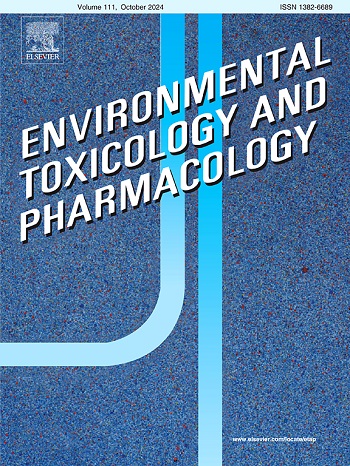Mixture effects of arsenic and chromium on erythrocytic nuclear abnormalities and expression of DNA repair, tumor suppressor and apoptotic genes in liver of zebrafish
IF 4.2
3区 环境科学与生态学
Q2 ENVIRONMENTAL SCIENCES
引用次数: 0
Abstract
The present study investigated the individual and mixture effects of Arsenic (As) and Chromium (Cr) at their environmental concentrations in zebrafish (Danio rerio). After 15, 30 and 60 days of exposure, increased frequencies of erythrocytic nuclear abnormalities (ENAs) were noticed. After 60 days of exposure, DNA damage was observed in liver and base excision DNA repair (BER) and mismatch DNA repair (MMR) pathways were studied to know the cellular responses. Altered expression of BER (ogg1, apex1, creb1, polb) and MMR (mlh1, msh2, msh6) genes indicated inhibition of DNA repair. Downregulation of tumor suppressor genes (p53 and brca2) occurred in mixture group. Downregulation of bax, caspase9 and decreased bax/bcl2 ratio indicated prevention of intrinsic apoptotic pathway in treated groups. Results indicated As and Cr-induced predisposition to genomic instability and carcinogenesis in zebrafish. Overall, this study confirmed the additive genotoxic effects of As and Cr in zebrafish erythrocytes and in liver after chronic exposure.
砷和铬对斑马鱼肝脏红细胞核异常及DNA修复、肿瘤抑制和凋亡基因表达的影响。
本文研究了环境浓度下砷(As)和铬(Cr)在斑马鱼(Danio rerio)体内的个体和混合效应。暴露15、30和60天后,发现红细胞核异常(ENAs)频率增加。暴露60天后,观察肝脏DNA损伤,并研究碱基切除DNA修复(BER)和错配DNA修复(MMR)途径以了解细胞反应。BER (ogg1, apex1, creb1, polb)和MMR (mlh1, msh2, msh6)基因的表达改变表明DNA修复受到抑制。混合组肿瘤抑制基因(p53和brca2)下调。bax、caspase9的下调和bax/bcl2比值的降低表明,在处理组中,bax、caspase9和bax/bcl2比值的降低预示着内在凋亡途径的预防。结果表明,砷和铬诱导斑马鱼基因组不稳定和致癌易感。总的来说,本研究证实了慢性暴露后砷和铬对斑马鱼红细胞和肝脏的加性遗传毒性作用。
本文章由计算机程序翻译,如有差异,请以英文原文为准。
求助全文
约1分钟内获得全文
求助全文
来源期刊
CiteScore
7.00
自引率
4.70%
发文量
185
审稿时长
34 days
期刊介绍:
Environmental Toxicology and Pharmacology publishes the results of studies concerning toxic and pharmacological effects of (human and veterinary) drugs and of environmental contaminants in animals and man.
Areas of special interest are: molecular mechanisms of toxicity, biotransformation and toxicokinetics (including toxicokinetic modelling), molecular, biochemical and physiological mechanisms explaining differences in sensitivity between species and individuals, the characterisation of pathophysiological models and mechanisms involved in the development of effects and the identification of biological markers that can be used to study exposure and effects in man and animals.
In addition to full length papers, short communications, full-length reviews and mini-reviews, Environmental Toxicology and Pharmacology will publish in depth assessments of special problem areas. The latter publications may exceed the length of a full length paper three to fourfold. A basic requirement is that the assessments are made under the auspices of international groups of leading experts in the fields concerned. The information examined may either consist of data that were already published, or of new data that were obtained within the framework of collaborative research programmes. Provision is also made for the acceptance of minireviews on (classes of) compounds, toxicities or mechanisms, debating recent advances in rapidly developing fields that fall within the scope of the journal.

 求助内容:
求助内容: 应助结果提醒方式:
应助结果提醒方式:


